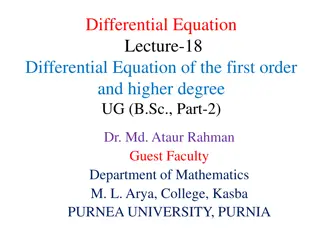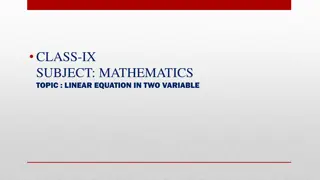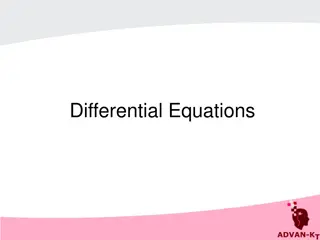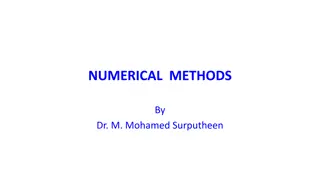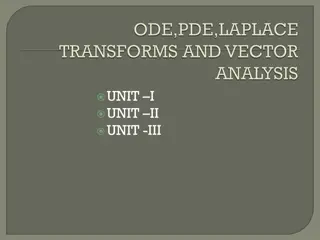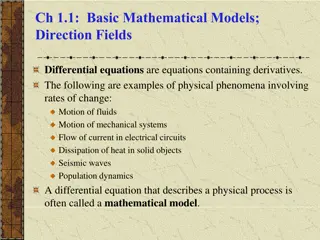Understanding Three-Dimensional Systems of Linear Ordinary Differential Equations
Explore the concepts of three-dimensional linear systems of ordinary differential equations, including techniques for finding eigenvalues and the general solutions. Learn how to determine characteristic polynomials for 3x3 matrices and identify sink, source, and saddle points in 3D systems.
Download Presentation

Please find below an Image/Link to download the presentation.
The content on the website is provided AS IS for your information and personal use only. It may not be sold, licensed, or shared on other websites without obtaining consent from the author. Download presentation by click this link. If you encounter any issues during the download, it is possible that the publisher has removed the file from their server.
E N D
Presentation Transcript
Three Dimensional Systems of Linear Ordinary Differential Equations Stephen Heim and Ellie O Brien
Outline I. General Solution of 3D Linear System of Ordinary Differential Equations II. Techniques of Solving for Eigenvalues in 3D linear systems A. The Easy Case B. Traditional way to find the determinant (linear algebra) C. Characteristic Polynomial for finding the eigenvalues 3x3 matrix III.Characteristics of 3D Linear Systems A. Sinks B. Sources C. Saddles
General Solution of a 3-D System of Linear ODEs The process for finding solutions of a three dimensional system is the same as when dealing with two dimensional systems. Given a linear system dX/dt = AX, where A is a 3x3 matrix and X = (x, y, z), a nonzero vector V is an eigenvector if: Where is the eigenvalue for V. If V is an eigenvector for A with eigenvalue , then is a solution of the linear system.
The Easy Case If the coefficient matrix corresponding to a three dimensional system of differential equations is upper triangular, we can read the eigenvalues off the diagonal of the matrix just like when dealing with two dimensional systems! Recall that an upper triangular matrix is a matrix for which all entries below the main diagonal are zero. For example: This system, when written in matrix form, is: where
Finding the Eigenvalues using the Determinant Recall from Linear Algebra that we can solve for the characteristic polynomial through finding the determinant of matrix: . Say we are given any 3x3 Then: The characteristic polynomial is then equivalent to: The result is a cubic equation, where we can then solve for the eigenvalues by setting the equation equal to zero.
Characteristic Polynomial for 3x3 Matrices The characteristic polynomial of a 3x3 matrix A can be written as: A = Where Or written explicitly in terms of the traces of matrix A as:
Characteristic Polynomial for 3x3 Matrices To derive the equation in terms of the traces, we must show that: We can combine these to get: We can see this is equivalent to the term: The last term is pretty nasty, so we will trust Wolfram that:
Equilibrium Points Some equilibrium points of 3 dimensional systems have similar classifications to those of 2 dimensional systems. Sinks: As time approaches infinity, solutions tend towards the point. Sources: As time approaches infinity, solutions tend away from the point. Others differ more noticeably from their two dimensional counterparts, as seen in saddle equilibrium points and several special cases.
Sinks Characteristics of Sinks for 3D systems: Three negative real eigenvalues, each with a corresponding straight line of solutions tending towards the equilibrium point. Or One negative real eigenvalue with a corresponding straight line of solutions tending towards the equilibrium point, and a complex conjugate pair of eigenvalues with a negative real component and a corresponding plane of solutions spiraling towards the equilibrium point.
Sinks Continued 3D Spiral Sink Eigenvalues Spiral Sink: -1 Negative Real -Complex Conjugate Pair (Negative Real Part)
Sources Characteristics of Sources for 3D systems: Three positive real eigenvalues, each with a corresponding straight line of solutions tending away from the equilibrium point. Or One positive real eigenvalue with a corresponding straight line of solutions tending away from the equilibrium point, and a complex conjugate pair of eigenvalues with a positive real component and a corresponding plane of solutions spiraling away from the equilibrium point.
Sources Continued 3D Spiral Source Eigenvalues Spiral Source: -1 Positive Real -Complex Conjugate Pair (Positive Real Part)
Saddles Saddle equilibrium points of 3D systems have a greater number of possible characteristics than sinks or sources (4 to be precise). These are: One positive real eigenvalue with a corresponding straight line of solutions tending away from the equilibrium point, and a complex conjugate pair of eigenvalues with a negative real component and a corresponding plane of solutions spiraling towards the equilibrium point. One negative real eigenvalue with a corresponding straight line of solutions tending towards the equilibrium point, and a complex conjugate pair of eigenvalues with a positive real component and a corresponding plane of solutions spiraling away from the equilibrium point.
Saddles Continued One positive real eigenvalue with a corresponding straight line of solutions tending away from the equilibrium point, and two negative real eigenvalues with a corresponding plane of solutions tending towards the origin (a two dimensional sink). One negative real eigenvalue with a corresponding straight line of solutions tending towards the equilibrium point, and two positive real eigenvalues with a corresponding plane of solutions tending away from the origin (a two dimensional source).
Saddles Continued Eigenvalues Real Saddle: -3 Real Spiral Saddle: -1 Real -Complex Conjugate Pair Spiral Saddle Real Saddle
Special Case (Example) In certain cases equilibria exhibit qualitative properties unlike those seen in Sinks, Sources, or Saddles. As with 2D systems, this usually occurs in a case of zero eigenvalues, repeated eigenvalues, or a combination of the two. Consider the equation: The eigenvalues of the upper triangular coefficient matrix are 1= 2= 3 = 0, so we have a case of repeated zero eigenvalues. (Note that in this case, we can read the eigenvalues off of the diagonal of the matrix)
Special Cases Continued By solving for eigenvalue =0, we get associated eigenvector: Thus every solution along the x axis satisfies the system when z is zero. When z is non-zero, x is quadratic in y; there are planes of parabolic solutions parallel with the xy plane for constant values of z. This is best shown with phase portraits of the xy plane for constant values of z:
Conclusions -Three-dimensional systems of linear ordinary differential equations often have properties analogous to their two dimensional counterparts. -If possible, it is convenient to first look at three-dimensional systems in terms of their behaviors in a two-dimensional plane and an appropriate phase line. -Methods of analyzing and solving two-dimensional systems can generally be utilized in three-dimensional systems with only minor modifications.
References "Algebraic and Geometric Multiplicity." University of Washington Math Department, 20 May 2013. Web. <http://www.math.washington.edu/~ansa1989/math308b_sp13_docs/lecture19.pdf>. Blanchard, Devaney, Hall. Ordinary Differential Equations. 4th Edition. Boston: Brooks/Cole CENGAGE Learning, 2012. Print. "Calculating the Characteristic Polynomial." Mathematics Stack Exchange. 12 June 2014. Web. <http://math.stackexchange.com/questions/832076/calculating-the-characteristic-polynomial>. Mitchell, Jonathan. "Linear Systems of DE: 3D Analog Surface (Real Eigenvalue Case)." YouTube. YouTube, 1 Jan. 2013. <https://www.youtube.com/watch?v=-yaINOrzpZI> Tao, Terrence. "Characteristic Polynomials." <.http://www.math.ucla.edu/~tao/resource/general/115a.3.02f/week8.pdf>. Weisstein, Eric W. "Characteristic Polynomial." From Mathworld--A Wolfram Web Resource. <http://mathworld.wolfram.com/CharacteristicPolynomial.html> Dawkins, Paul. "Differential Equations." Paul's Online Notes. Lamar University. Web. <http://tutorial.math.lamar.edu/Classes/DE/HOSystems.aspx>.




